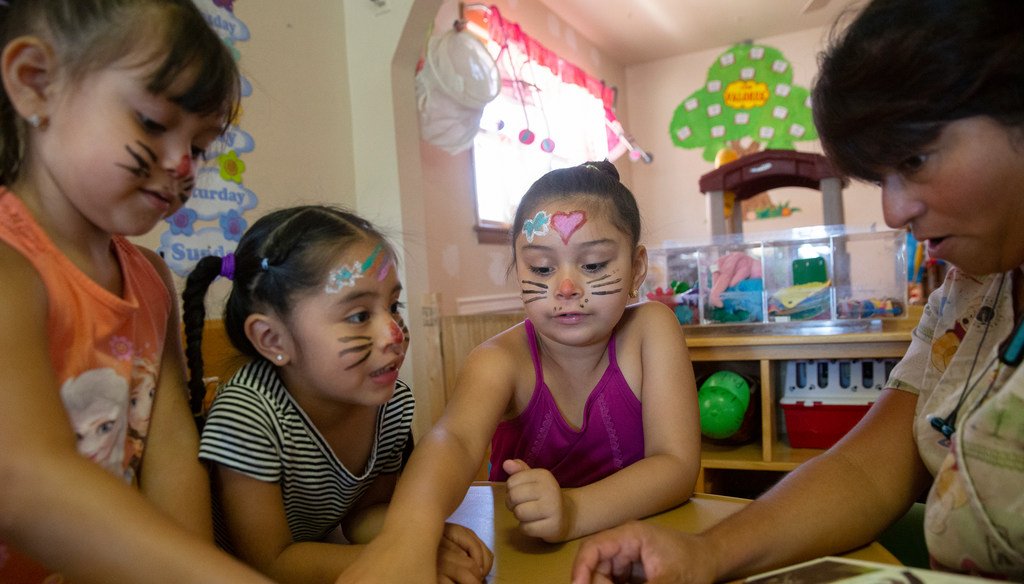Access to affordable child care is one of many societal shortfalls exacerbated by the coronavirus pandemic.
For low-income parents in particular, quality center-based care can be financially out of reach, leading them to cobble together arrangements with family, friends and home-based options that may not guarantee needed safety and consistency. Even before COVID-19 further limited available options, a 2019 study found center-based child care is unaffordable for 63% of full-time working families.
Wisconsin State Treasurer Sarah Godlewski — a Democrat and potential 2022 U.S. Senate candidate — sought to highlight this crisis in a recent tweet.
"On average, 17% of a family’s income goes towards child care in Wisconsin," Godlewski wrote on Feb. 6, 2021. "That's ridiculous! Washington must provide financial relief to help struggling families with these ever-rising costs."
Her tweet included a chart showing Wisconsin ranked eighth-worst in the country by that metric according to an analysis by Lending Tree.
Godlewski is right that a crisis exists, but she’s a bit off in how she presents the numbers.
Let’s take a closer look.
Getting the details right
Godlewski cites Lending Tree as her source, which is somewhat less than an authority on the subject. The website is an online loan marketplace that like many other online vendors uses geography-based breakdowns like this to attract website visitors.
The group isn’t far off in their analysis, though.
Child Care Aware — a national advocacy organization pushing for quality, affordable child care — found the average monthly cost of full-time child care at a child care center is $996 per child in Wisconsin, which is equivalent to 18% of median household income for a family with children under 6.
Lending Tree cited a 17% figure for center-based care as a percentage of income using average income. Statisticians typically use median income rather than average to determine rates like this, so outliers such the highest income earners don’t skew the calculation.
But there are several key caveats in the Child Care Aware stat (and the similar Lending Tree one) that Godlewski’s wording disregards.
-
The cost is per child, not per family.
-
The cost refers to full-time, center-based care. Many families use home-based care options or friends and family, or use a combination of those options and center-based care.
-
The percentage comparing child care cost and income is an equivalency, rather than an average as Godlewski frames it.
The third point takes a bit more explanation. Imagine two families who each had one child. If one used relatives for child care and had no cost, and the other used full-time, center-based care and paid 34% of their income for that, the two families would average a cost of 17%. That’s the picture painted by Godlewski’s phrasing, that the average cost among families with children is 17%. But that’s incorrect.
That figure is only accurate when referring to the group of families that have exactly one child under 6 in child care, with that child attending full-time in a center-based setting. And that’s not a typical child care situation. Only about 24% of children under 6 were in center-based child care full time in 2019, said Sarah Grady, study director of the National Household Education Survey, a federal program administered by the National Center for Education Statistics.
In actuality, that stat (18%, according to Child Care Aware) is simply an equivalence. It is stating that the cost of putting one child in a full-time, center-based care is equivalent to 18% of the typical income for a family with children in that age range.
We should also note that the cost relative to income predictably changes drastically based on the number of parents and children involved. For example, Child Care Aware says the full-time center-based care option would be equal to 37% of median household income for a single-parent family with one child under 6.
How many parents pay for child care
Godlewski’s core point is about families paying for child care, so here’s what we know on that point. You can look at this statistic in terms of children or in terms of families.
On a per-child basis, about 40% of children 5 and under were in at least one out-of-home child care arrangement that parents paid for nationwide, according to the latest data from the National Household Education Survey. That includes those that pay for just a portion of a week and use any type of paid child care, not just licensed centers.
In terms of working families, the Center for American Progress, a liberal public policy research and advocacy organization, estimates 55% of working families pay for some portion of child care. Again, that includes those that pay for just a portion of a week.
Predictably, higher-income families are more likely to use licensed child care centers, the Center for American Progress found, again limiting the usefulness of the average family metric Godlewski invoked. Among the 20% of families with the highest income, 66% used licensed child care; but only 33% of families whose income was in the bottom 20%.
Our ruling
Criticizing the high cost of child care in Wisconsin, Godlewski claimed, "On average, 17% of a family’s income goes towards child care in Wisconsin."
She’s right that child care costs can be a financially impossible burden for many families. But her stat misses on several points.
That figure isn’t an average, it simply compares the price of full-time, center-based child care to the typical family income, expressing that ratio as a percentage. This number only holds true for a family with one child who has that child in full-time center-based care, which is far from a typical situation. Many families use a combination of options, or pay for home-based care.
And this phrasing actually drastically understates the cost for a single-parent family or a family with multiple children using center-based care.
We define Half True as a statement that is partially accurate but leaves out important details or takes things out of context. That fits here.




